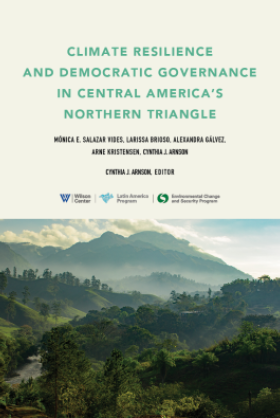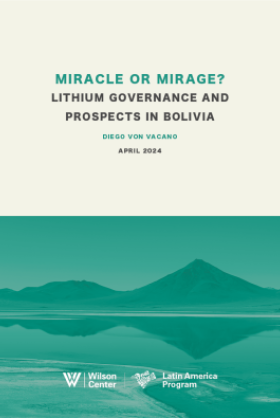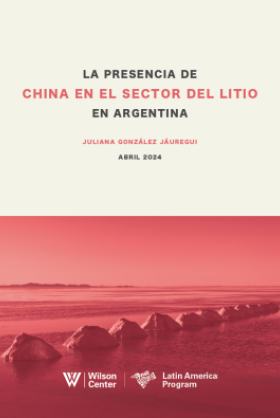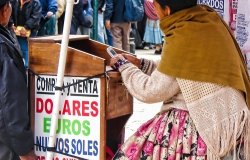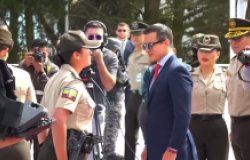"Reporting on the Neighbors: A Conference of Mexican and U.S. Journalists"
Overview
On April 26, 2004, the Wilson Center's Mexico Institute joined Foreign Affairs en Español to bring together journalists from both sides of the border for a day of panel discussions centered on the challenges of reporting on both politics and broader issues in society in each others' countries and of covering news from and about the growing Mexican and Mexican-American community in the United States. This is the second conference in a series of three, where over forty journalists, scholars, and policymakers participated in a dynamic and intense discussion focused on cross-border reporting.
Roderic Ai. Camp, Professor at Claremont McKenna College, offered the keynote speech, setting the stage for the conference by highlighting significant areas in which journalists could take an initiative to promote better understanding of the other country. From an academic's point of view, Camp advised journalists to consider presenting the ordinary side of both cultures despite the challenge of selling these types of stories to editors; identifying and exploring other worthy topics and actors that may not be considered "news" usually; and anticipating and approaching forthcoming public policy issues in more depth in order to raise the caliber of the debate [full remarks available separately online].
The morning panel, Covering Politics across Borders, began by discussing the obstacles and responsibilities reporters face when covering the politics of the other country, including dealing with stereotypes and the difficulty in selling their stories to editors. The ease with which the media creates stereotypes is too often overlooked and certainly not discussed enough within the media, noted Dolia Estévez of El Financiero. Working as a Mexican correspondent in Washington, DC, Estévez believes that the Mexican media has an important role to play not only because of the indirect influence the media has in shaping policy, but more importantly because the public's opinion is often formed by the stories in major newspapers. Although the media's coverage of each other's country has increased significantly since the 1990's, not enough stories are ahead of the curve to take a look at cutting-edge issues. The stories covered, unfortunately, tend to concentrate on many of the same issues that have been covered in the last decade: immigration, drugs, trade, and corruption
Mary Beth Sheridan from the Washington Post, addressed the tendency of reporters to analyze a situation in black and white terms. Covering politics across borders is no easy task and the temptation is to relegate issues such as drug trafficking and corruption to simplistic stories of good versus evil. This is a challenge she often sees reporters struggle with, herself included. The challenge is, however, not only the willingness of a reporter to write the story but also whether she or he can sell it to an editor.
Pascal Beltran-del-Rio of El Universal/La Revista criticized the media's tendency to portray the bilateral relationship in simplistic terms thereby exacerbating the already incomplete coverage of news. He noted that Mexico's current place among the priorities of the Bush Administration produces frustration not only among American correspondents in Mexico, but also among those heavily involved in bilateral issues. The media has a responsibility to tell the complete story, yet it seems that many newspapers give very one-sided stories. Beltran-del-Rio recounted how Mexican reporters recently overplayed allegations that a group of British soldiers trapped in Mexican caves were searching for uranium for nuclear weapons. Had reporters conducted a better investigation, the British men would have been receiving praise in newspaper stories about their extensive and honest contribution to research. In short, reporters help frame foreign policy issues in ways that influence policy decisions in important ways, and shoddy reporting can often undermine national interest by distorting the way that citizens view events around them.
The second panel of the morning's session, Understanding Each Other's Society, set out to discuss the broader issues in society reported on by the media inclusive of stereotyping, immigration and border issues. Alfredo Corchado from the Dallas Morning News, noted that understanding the two societies is not an easy task to undertake, particularly when working with diverse readers. Stories frequently have to cater to a diverse mass readership and "readers ask one question: what does it mean to me? how does it impact me?" Accommodating stories for both Mexican and non-Mexican readers requires creativity in reporting on everyday stories. In one instance, Corchado covered the response from Mexican immigrant families who saw their children go off to fight in Iraq, as an appealing angle on the war in Iraq.
According to Jim Cason of La Jornada, Mexicans' knowledge of the United States beyond Washington and Hollywood is far too scant. Cason argued that as reporters, breaking stereotypes begins with the knowledge that readers do not know enough. Furthermore, he points out that the stories that are the shades of grey, as opposed to the black or white versions, are the most interesting stories despite the difficulty in publishing them. Unfortunately, the subtle pull and the pressures to publish a bigger headline often dominates. Reporters are frequently forced to choose between the stories that most interest them and those they know will get on the front page.
Jerry Kammer of Copley News Service argued that Mexican correspondents need to further the immigration debate in Mexico by reporting about areas that are not traditional migrant receiving communities across the United States such as Georgia, North Carolina and Illinois. The latest census figures show that these states have considerable increases in migrant populations. Reporters could also cover stories of migrants that go beyond the tale of an immigrant migrating north to work as a farmworker and suffering under a hypocritical American boss. In human terms, there are also important stories to tell about established Mexican-Americans in the United States for a Mexican audience, yet much of this remains untold.
During a lunchtime panel, the editors of three major news publications each gave their thoughts on the priorities and changing trends of journalistic coverage. Phil Bennett of the Washington Post maintained that coverage of Mexico-US relations has become "de-institutionalized," with journalists covering a broad range of topics outside of formal politics. Despite the current breadth of coverage by reporters, Bennett suggested that four kinds of additional coverage were needed: first, narrative stories that move beyond Mexico City and into other parts of Mexico to give U.S. readers a more complete view of Mexico; second, stories that deconstruct economic, political and cultural reasons behind the status quo; third, deeper analysis of social conditions, such as analyzing the reasons for the perseverance of extreme poverty in Mexico; and fourth, additional coverage of the evolving ways in which United States and Mexico continue to exert change on one another. He noted that the Mexico-U.S. relationship, like the China-U.S. relationship, was likely to "change history" and, therefore, merited greater coverage than other countries. Mexico will also continue to separate itself from the rest of Latin America in terms of journalistic coverage. However, reporters need to stay aware of emerging stories, especially those generated by non-elite actors, and pay attention to the stories of Latinos in the United States, who are not adequately covered in the media. Finally, he observed that the internet will matter more as a "vehicle for carrying news freely across the border and for creating new forms and new audiences and more critical demand for information." This trend will also have profound effects on how media coverage affects bilateral affairs.
Rossana Fuentes-Beraín of Foreign Affairs en Español noted that "editors are surely story tellers and in that sense the story we have been telling is an incomplete story." Declaring that journalism is in a state of crisis, she observed that the Jason Blair episode is a testament to the loss of objectivity in American journalism and that Mexicans' self--censorship and official silence on key matters is the result of a collective mentality pervasive throughout the country. The press is still learning to deal with the new situation of openness in Mexico. Both understanding and reporting about this new context is the challenge for reporters. Editors' responsibility remains in finding a balance between what sells and what the reader wants. Whether editors reflect the reader's wishes or not, however, is another question for debate. However, Fuentes-Beraín recognized that there is a growing distance among editors and the public. Regrettably, survival or complacency is what defines many of the newspapers within Mexico thus reflecting the types of stories published. In the meantime, in the United States it is increasingly difficult to pursue innovative stories about Mexico when the reality of the current situation is so fixated on the Middle East and homeland security issues. In conclusion, she argued that editors should not just educate the public, but should reach out to them to better understand the reader's wishes.
As the public opinion editor for Reforma, Alejandro Moreno noted that in five years he and his team have interviewed over five million people from the general Mexican population. Interestingly enough, polls are almost in their entirety front-page stories both in Mexico and in the United Staets. In 2003, Reforma carried out 150 polls- ten times more than The New York Times and the Los Angeles Times. Since many of polls are considered a primary source for other analyses, about 75-80% of the poll reports find a place on the front-page news. Moreno observed that with elections on the horizon, polls become increasingly important and frequent. Just as journalists are storytellers, Moreno believes that polling tells a different kind of story; one just as compelling with the use of numbers and graphs that supplement narrative stories. Polls have the capacity to either pose or answer questions and in essence, they are slowly becoming historians by tracing the trends of the Mexican electorate over periods of time. They also may contribute to the democratization of information by showing what average readers think rather than just reflecting the views of political and cultural elites.
The final panel of the day, Covering Mexicans in the United States, sparked a vigorous debate about the coverage of immigrants, first generation Mexican-Americans and other Latinos residing in the US. Michael Jones-Correa, scholar at the Wilson Center and from Cornell University argued that it is the responsibility of reporters to portray a complete story, but that reporters often do not contextualize their stories to give the readers a better understanding of the overall situation. He pointed out three areas of concern to Latinos in the United States that are often reported out of context. First, the predominant image of immigrants from Mexico in the media (of both countries) is that of immigrants illegally crossing the border. What reporters fail to report is that Mexico is the largest sender of legal immigrants (22% of total legal immigrants), while the next largest country is India (7% of total). Furthermore, legal immigrants outnumber undocumented immigrants by two-to-one, according to INS figures. Additionally 85% of all Latinos living in the US under the age of 18 are native-born. Second, reporters often describe migration from Mexico as temporary and cyclical; however, this represents only a small part of the Mexican population in the United States. Return rates are actual quite low, and they are certainly no higher today than at any other point in history. Third, the story about remittances has been overplayed in the media by giving the impression that remittances are a larger portion of income than is really true. Reporters often fail to note that immigrants are sending back only 4-5% of their income back to their home country. The other 95% is spent and invested in the United States. While the stories reported by media generally capture important truths, they could be of greater service to readers by giving a fuller picture of migration trends and of Latinos in the United States.
Lynne Walker of Copley News Service described a story she had covered on the effects of an influx of migrants, primarily Mexican, into a small, rural town outside of Springfield, Illinois. Within a couple of days, Walker had made inroads into the community, both among migrants and long-term residents, and was able to explain the project to them. Walker stressed the importance of creating these bridges of communication to build a sense of trust and to truly obtain all sides of the story, which are often shades of grey. When working with immigrants, Walker felt both enlightened and gratified by the story she was retelling the readers. She began to understand the difficulties of living under a pseudonym and the reality of this sub-culture of immigrants in the middle of rural America. Reporters often wrestle with the question of who reporters are writing for. Stories about Mexico and about migrants are not necessarily directed at Mexicans or even Latinos in the United States; on the contrary, the American public should be just as educated about issues in Mexico as any other individual. Walker concluded by stating that "[reporters] have an obligation to tell [the readers] as much as [they] can, as fairly and accurately as [they] can."
Enrique Gomez from A.M. León asserted that Mexico's political destiny lies in its relationship with the United States, and the United States' destiny with Mexico. Over the last forty years, migration from Mexico has been transforming the United States, as witnessed by the growth of Mexicans and Mexican-Americans as an economically and politically powerful group in cities such as Los Angeles, Chicago and New York City. The important lesson has been "the slow but inevitable fusion of two nations across family and economic ties. Every time a Mexican crosses the border, he takes with him an invisible string that connects him back to his roots. Every year, 300,000 million strings strengthen this network, further deepening the relationship between Mexico and the United States." Testament to a deepening inter-dependence is the rise of local and regional Spanish-language newspapers across the United States. In the future, Gomez expects American newspaper chains to merge with these Spanish-language newspapers or buy them out. These migrants and their descendants are also transforming Mexico and becoming a key part of Mexico's political and social consciousness. In the future, he noted, "politicians will seek these probable votes [from Mexicans in the United States] to launch their candidacies for the Mexican presidency; businesses will seek their growing purchasing power; while journalists will seek the stories of the paisanos and their jornadas to bring one nation unto the other." The Mexicans who live in the United States and Americans of Mexican descent will become the bridge that joins the two countries together and a significant presence in the press coverage of both countries.
The conference generated substantial discussion on a range of issues in bi-national press coverage. Among many of the issues that emerged during the roundtable discussions centered on the media's role in the bilateral relationship, media's coverage of each other's country to move beyond politics while at the same time presenting stories that are fair and accurate. Constrained by the realities of reporting, journalists face a number of challenges in reporting across the border. In essence, the participants accepted and acknowledged that readers have a very incomplete vision of each other and much work is yet to be made, equally by editors and reporters.
Hosted By

Mexico Institute
The Mexico Institute seeks to improve understanding, communication, and cooperation between Mexico and the United States by promoting original research, encouraging public discussion, and proposing policy options for enhancing the bilateral relationship. A binational Advisory Board, chaired by Luis Téllez and Earl Anthony Wayne, oversees the work of the Mexico Institute. Read more
Thank you for your interest in this event. Please send any feedback or questions to our Events staff.
